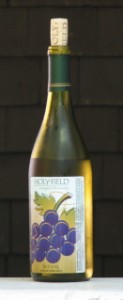They came. They tasted. They were surprised and pleased. That’s the nutshell result of a group of friends’ tasting local wines. Kansas wines. Mostly Douglas County wines. (Kansas licenses several more wineries, too.)
To recap, here are the wines we tasted and the order we tasted them in:
- Seyval. Holy-Field. $12.95. (In photo at right, which is in focus, but it’s chilled and instantly collects condensation.) Also, a Seyval from Kugler’s, which a couple of our tasters brought, as Kugler’s is their neighbor.
- Vignoles. BlueJacket Crossing. I think this was about $10.
- Corky’s Barrel. Holy-Field. A red blend of Chambourcin, Cynthiana (a.k.a. Norton) and Foch, $10.95. Someone over the phone identified the grapes for me, and I swear she said it was spelled Fouche. I was unable to find any information about a Fouche grape, so I’ve concluded it must in fact be Marechal Foch, a.k.a. simply Foch.
- Wolf Red. BlueJacket Crossing. An off-dry red made from Chambourcin and St. Vincent grapes and aged in American oak.$11.00.
- Charlemagne. Davenport Winery. Chambourcin. $12 (I think)
The whites
If I had it to do over, I’d have started with the Vignoles rather than the Seyval, but we didn’t. No matter. The Holy-Field Seyval was greeted with “I love it!” and “Oh! This is good!” and then Brian pronounced that it “compares favorably with some very expensive California Rieslings.” I wouldn’t know, but it was, as the vineyard’s flier declared, a fine wine, delicate and crisp with loads of apple character. It had as much complexity and body as any white wine I can think of.
Then we had the Kugler Seyval. It had some of the same flavors but was overlain by excessive sweetness and didn’t match up.
Next, we went to the Vignoles, a sweet (or maybe off-dry) white with distinct grapefruit and other citrusy flavors. It’s good. It is, however, distinctly lighter than the Seyval and suffered a bit from the comparison, which is why I wish we’d served it first.
The reds
 Since we weren’t able to get any dry wines, our reds were off-dry to sweet. We started with Corky’s Barrel, which again was quite satisfying, with a medium body and layered flavors. The Wolf Red (at left) had a similar character but more sweetness.
Since we weren’t able to get any dry wines, our reds were off-dry to sweet. We started with Corky’s Barrel, which again was quite satisfying, with a medium body and layered flavors. The Wolf Red (at left) had a similar character but more sweetness.
The meal
After tasting those wines, we adjourned to dinner, where we feasted on local chicken (both as chicken salad and chicken Marbella), local beef brisket (fully pastured, on the guests’ own property), a salad featuring local kale and roasted peppers. We also had local cucumbers, peppers and a little bit of melon to snack on.
I guess it’s an indication that summer’s peak has passed, as no one brought the tomatoes or beans I might have expected. Nevertheless, it was all delicious. The two Holy-Field wines were the most popular choices to go with dinner.
The finishing flavors
We saved the Charlemagne to serve with dessert. It was medium- to full-bodied and sweet, and it complemented the Balsamic-Goat Cheese Pears quite nicely.
Local wines where you live
The biggest drawback to these wines is that they aren’t generally available at your neighborhood liquor store. The proprietor at mine said that’s because the Kansas wineries generally don’t produce enough to interest wholesalers, and wholesalers are where most retailers get their stock. I know I have seen Kansas wines in stores from time to time, but not consistently. Maybe I’ll look into that more at a future date.
Meanwhile, although its information may not be entirely up to date, the Appellation America web site’s appellation index lets you click on your state and see the appellations available there. Yes, there is wine-making in North Dakota. Utah, West Virginia and Vermont, too. Check out your state. Do you drink local wines?

We love the folks at Holy-Field and are always glad to see them appreciated.
Kansas wine tour leaves pleasant taste in mouth | foodperson.com // Oct 6, 2008 at 10:29 am
[…] Read about our later wine-tasting. […]